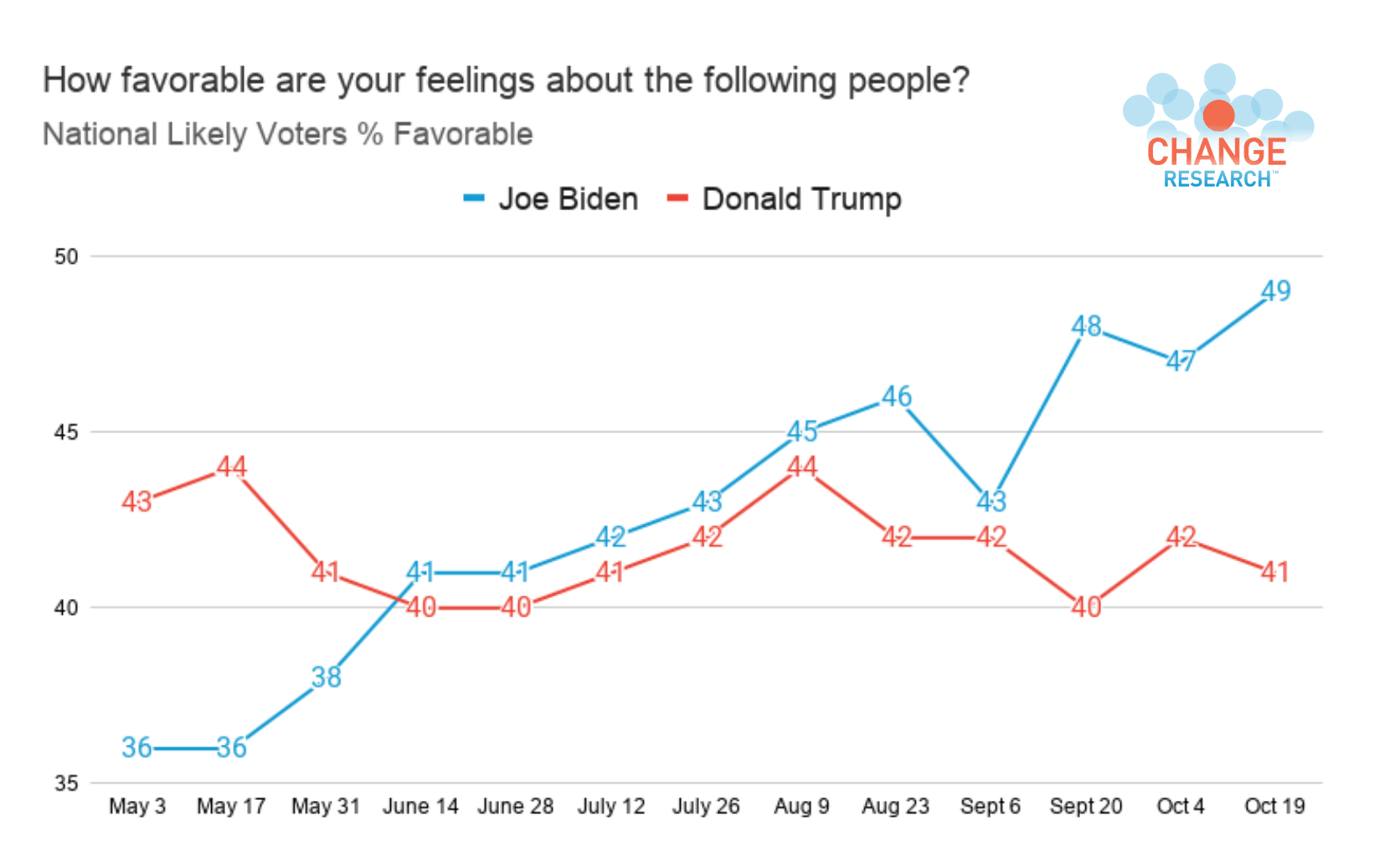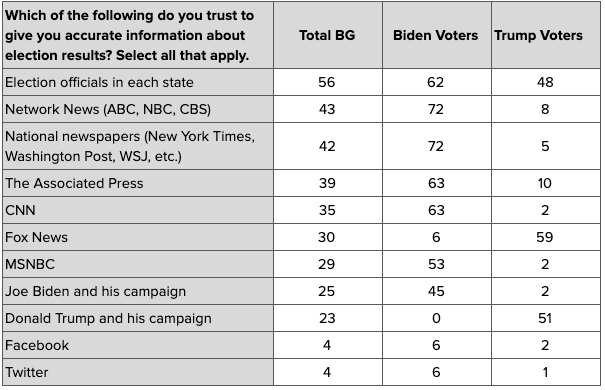Change Research/ CNBC Poll: October 16-18, 2020
Key Takeaways
Biden +10 nationally and +4 in the competitive battleground among likely voters
Biden leads by 10 points nationally (52% to 42%), unchanged over the past two weeks. Biden also leads by 4 points across the six state battleground — six states Trump won in 2016 — as he has since mid summer. Biden continues to lead in each of these states.
- +6 in Arizona (51 to 45)
- +5 in Florida (50 to 45)
- +7 in Michigan (51 to 44)
- +3 in North Carolina (50 to 47)
- +2 in Pennsylvania (49 to 47)
- +8 in Wisconsin (52 to 44)
There are remarkably few undecided voters and third party voters for Trump to consolidate at this stage, and Biden is claiming at least half of the vote in most of these states, making Trump’s path even more narrow. Trump’s best chance to win the Electoral College requires winning in Florida, Pennsylvania and North Carolina and at least one other state where he currently trails in the polls. While our polls have shown Biden winning in all of these states for the better part of the past 5 months, the contest in those three must-win states are still within the margin of error.
It is hard to understate enthusiasm for voting this year. A massive 92% of battleground voters and 91% of voters nationally report they are ‘extremely motivated to vote’ in the election, giving a 10 on a 0 to 10 scale. Most of the voters who have already voted are the most highly motivated: 95% of those who have already voted in the battleground are ‘extremely motivated’ while 90% of those who have not yet voted are 10s. A large minority of our respondents report having already voted. Nationally, 53% of Biden voters report having voted already compared to just 25% of Trump voters.
Trump’s base strategy is not giving him the enthusiasm advantage he would hope to see considering he trails in the polls. The hope is that there are more highly motivated Trump voters who will be sure to turn out on Election Day and that some of those weaker Biden voters will stay home. But 93% of battleground Biden voters are ‘extremely motivated’ compared to the 94% of Trump voters. If you filter the ballot to only those who are 10s in motivation, Trump only picks up 1 point in the ballot across the battleground.
Opinions of Trump became more favorable two weeks ago when Trump was hospitalized for COVID, moving from +17 net unfavorable nationally to +12 net unfavorable. This was the only evidence of sympathy for Trump in our polling, and it has been short lived. Trump’s favorability is 15 points net unfavorable (41% favorable, 56% unfavorable). He is less unpopular in the battleground, where opinions of him are 8 points net unfavorable (44% favorable, 52% unfavorable), but even here 51% of voters are very unfavorable towards Donald Trump. Meanwhile, opinions of Biden continue to improve: opinions are +3 net favorable nationally and are net-neutral in the battleground (48% favorable/ unfavorable), the highest measured in our polling.

Despite Trump’s huge favorability deficit, only John James in Michigan is running better than the President (51% Peters, 46% James). Mark Kelly leads Martha McSally by 11 points (54% Kelly, 43% McSally) and Cal Cunningham leads Thom Tillis by 6 points (51% Cunningham, 45% Tillis). These incumbents hope to meet Trump’s vote share, as most figures in the GOP are less popular than even the President.
Voters concerned Trump won’t accept the election outcomes and few trust him on election outcomes
For the first time in our polling, a 51% majority of voters in the battleground and 54% nationally say they expect Biden to win the election. So there is no longer a presumption that Trump will win working in his favor. But voters do worry that Trump will not accept the outcome of the election. A 52% majority nationally and 49% of battleground voters are very or somewhat concerned that Trump will not accept the outcome of the election unless he wins. That includes 63% of white college women — the “suburban women” that have been trending towards Democrats — and even 48% of white working class women who voted 2:1 for Trump in 2016. By comparison, only 37% of background voters and 33% nationally say the same of Biden.
The most trusted messengers for information about the results are election officials in each state, followed by the networks, and national newspapers. Only about one-quarter say Biden and his campaign or Trump and his campaign. Among Biden voters, national networks are the most trusted sources, perhaps reflecting some Biden voters’ lack of trust in GOP state officials. Among Trump voters, the most trusted source of information was Fox News, followed by Trump and state election officials. The good news for those concerned that Trump will try to claim victory unduly is that the numbers who would turn to him and Fox as authorities on this are not large.

It has been suggested by the President that the Supreme Court may play a role in determining the outcome of the election. Voters believe that Barrett should recuse herself by a 9 point margin (49% to 40%) with the rest unsure.
SCOTUS Hearings
A large 84% majority of voters nationally and 85% of battleground voters say that they have been following the SCOTUS confirmation hearings closely and 45% say that they have been following them very closely (46% in the battleground).
Only 3% of voters nationally are unable to identify Amy Coney Barrett, down from 9% unable to identify her in our Debate Night Poll at the end of September. After a week of hearings, opinions of Barrett have worsened and opinions are now 5 points net unfavorable nationally (47% unfavorable, 42% favorable). With the exception of Brett Kavanaugh, that has not been the trend for SCOTUS nominees, and caught us by surprise as the Democratic opposition has avoided personal attacks on Barrett. Opinions are mixed in the battleground (46% favorable, 43% unfavorable), but voters there still would prefer for Democrats to select the next justice.
A 53% majority nationally and half of battleground voters say that the winner of the next election should fill this seat, with 45% nationally and 48% in the battleground saying Trump and the current Senate should fill it. A 52% majority of battleground voters continue to think that Biden and Democrats would do a better job of selecting a Supreme Court nominee than Trump and Republicans. That includes a majority of voters in every battleground state except for Pennsylvania, where voters are split 50-50.
When it comes to the things that are at stake in the Supreme Court nomination, battleground voters give Biden and Democrats hold advantages on every issue nationally and every issue but one (gun laws) in the battleground, where voters say Trump and the GOP would do a better job by 2 points. Their greatest advantage is on abortion or a woman’s right to choose (60%), followed by protecting pre-existing condition protections (55%) and combating racism and discrimination (54%).
A 54% majority of battleground voters and 57% nationally have serious concerns that “pre-existing condition protections established by the Affordable Care Act will be eliminated” if Barrett is confirmed, with 47% of battleground voters and 50% nationally very seriously concerned. So, the threat to the ACA — which voters now rate favorably — and its pre-existing condition protections which Democrats have put front and center has broken through. As context, 49% of battleground voters and 53% of voters nationally are favorable towards the ACA, and public polling continues to find very large majorities of voters support pre-existing condition protections.
52% of battleground votes and 54% nationally have serious concerns that “Roe v. Wade, the decision that affirmed a woman’s right to an abortion, will be overturned” if Barrett is confirmed, with 44% of battleground voters and 46% nationally very seriosuly concerned.
The Republicans and Trump have attacked Biden and Democrats for failing to make clear whether they intend to “pack” the court with additional justices. We asked voters how serious were their concerns that this would happen if Trump’s nominee was confirmed and 50% of voters in the battleground and 47% nationally said this was seriously concerning to them. But this is unlikely to change the course of the race if Biden were to support this. There are so few undecided voters, and only 4% of Biden supporters who have not yet voted express very serious concerns about this, compared to the 82% who are very seriously concerned about Roe being overturned or the 87% very seriously concerned about the preexisting condition protections being eliminated. This would probably serve more to reinforce negative partisanship among Trump voters than persuade or demoralize Biden voters.
Large majority of voters would prefer for Congress to prioritize COVID-19 relief over SCOTUS
The large majority of voters in the battleground say that instead of filling the Supreme court vacancy, the top priority for the U.S. Senate right now should be providing more economic relief and funds for combatting COVID-19 (62% COVID relief, 38% SCOTUS). Only the white working class men – the heart of Trump’s base – are more likely to prioritize the vacancy (58% SCOTUS, 42% COVID relief).
Asked which comes closer to their point of view about the economy, battleground voters are twice as likely to say that “The economy is struggling and we need more financial relief from Washington” over “The economy is recovering and we do not need any more financial relief from Washington” (66% to 34%), up 3 points since we last surveyed.
Battleground voters are as likely to blame Trump and Republicans in Congress as they are to blame Nancy Pelosi and Democrat in Congress for failure to pass new COVID-19 relief, with 10% saying they are both equally to blame. This was also the reaction of voters when the expanded unemployment benefit expired.
When we look to those who are currently experience lost wages or a salary cut in their household, they are far more likely to say the economy is struggling and we need relief from Washington (77%), they are as likely to rank the economy, jobs, and cost of living as a top issue as are those who are experiencing lost jobs or wages currently, and they are more likely to say that Trump and Republican are more responsible for the failure to pass more relief (54% v. 34% Pelosi and Democrats, 11% both equally).
Trump’s closing COVID-19 message is not helpful
Voters continue to prefer Biden and Democrat to Trump and Republicans on COVID-19 by 6 points in the battleground and by 12 points nationally. But that understates the frustration with Trump’s handling of the virus. Fully 55% of battleground voters and 57% nationally disapprove of Trump’s handling of the virus, with majorities strongly disapproving. We also see Trump’s weakness on COVID-19 when we look at the 11 point intensity advantage that Democrats hold on COVID-19: 48% of battleground voters strongly prefer Biden compared to 37% who strongly prefer Trump.
That weakness is also apparent from the Trump voters who will not endorse Trump’s actions when it comes to COVID-19. For instance, we showed voters this tweet and asked them if it is mostly helpful or harmful when it comes to handling COVID-19.

Just 35% of battleground voters said this was helpful and 51% said it was harmful, while another 14% said it didn’t make a difference. Only 76% of Trump battleground voters say that this is helpful. The more Trump goes on the campaign trail, the more he plays up this weakness with his own voters, as only 59% of his Trump’s voters nationally believe that indoor campaign rallies are safe at this stage of the virus.
At the same time, a 48% plurality in the battleground and a 51% majority nationally say that things are getting worse when it comes to the impact of the virus. Voters just do not believe that things are under control as we head into the cold weather months and the election.
For media inquiries, please email [email protected]
Change Research conducted a poll of 2,949 likely voters October 16-19, 2020 across 6 competitive battleground states: Arizona, Florida, Michigan, North Carolina, Pennsylvania, and Wisconsin. A companion national survey of 2,711 likely voters was conducted October 17-18, 2020. Unless otherwise stated, the results presented in this analysis are among battleground state voters. The margin of error, as traditionally calculated, is ±1.8% for the battleground and ±1.88% for the national poll. Change Research reaches voters via targeted online ads that point people to an online survey instrument. Our Dynamic Online Sampling establishes and continuously rebalances advertising targets across region, age, gender, race, and partisanship to dynamically deliver large samples that accurately reflect the demographics of a population. Post stratification was done on state, gender, age, race, education, and 2016 presidential vote.
This is the 16th in a series of bi-monthly battleground state and national surveys that CNBC & Change Research will conduct in 2020.
